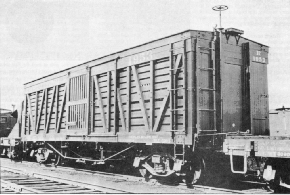Remembering the Rutland - Capsule History
RUTLAND 36' SINGLE-DECK STOCK CAR Nos. 1947 –1953
(courtesy of Rutland Car Shops)

Rutland Single Deck Stock Car #1953
Photo: Walter Pecan
Collection of Ray Muntz
The Rutland Railroad is well known for the large quantities of fluid milk it carried from the prime agricultural areas of Northern New York State and Vermont's Champlain Valley to markets in Boston and New York City. Given the rural nature of the railroad it is not surprising, although perhaps not widely known, that the Rutland also handled a relatively steady stream of inter-line and off-line livestock movements. To accommodate this traffic, the Rutland owned a fairly sizable stock car fleet (totaling 84 cars in 1903). By the early 1950s, the Rutland's stock car fleet had dwindled to a mere 16 cars, its numbers reduced by old age, wrecks and accidents, the wartime scrap effort and finally competition from trucking interests. At least two stock cars, numbers 1926 and 1971, are known to have lasted until 1956 - relegated to maintenance of way service hauling ties and cedar posts for the section gangs.
Among the longest-lived stock cars in the Rutland fleet were the 36', 60,000 lb. capacity stock cars of the 1940-1980 series built in 1903 for the Rutland by the Laconia Car Company of Laconia, New Hampshire. These distinctive cars are characterized by their truss-rod, steel center sill underframes, Bettendorf T-section trucks, and the relatively short 7'8' inside height of their all-wood superstructure. Originally built as single-deck cars, several of their number (cars 1970-1973) were converted into double-deck stock cars in 1914. These cars were later returned to their single-deck configuration in 1921. According to Rutland historian Steve Mumley whose father was a brakeman on the Rutland, there was a time when the railroad moved one to two car loads of hogs per week off the Ogdensburg and Lake Champlain division of the Rutland to the MacKenzie Meat Packing Company plant in Burlington. The hog movements utilized the double-deck stock cars when possible. The double-deck cars were likely to have also been used to move sheep as Vermont was at one time a world leader in Merino sheep production, shipping breeding stock all over the country.
Equipment Register wreck reports provides some information on just how widely traveled the Rutland stock car fleet was. At least 15 cars were lost on the New York Central and Pennsylvania Railroads between 1910 and 1920. Documentation of wrecks on the Chicago & Alton, Illinois Central, Chicago & Illinois Western, and the CCC&STL Railroads suggests that the Rutland cars may have also frequented the stockyards of the Chicago area. They apparently ranged even further west of Chicago as indicated by wrecks on the CB&Q, AT&SF, and the Union Pacific Railroads.
When not transporting livestock, Rutland stock cars were also used to move hay from Rouses Point to points south. Traffic statistics taken from the Rutland Railroad's 1920-1921 Annual Report reveal that in 1920 the railroad moved 3,982 car loads of hay and straw, 1,169 car loads of cattle, 88 loads of horses and mules, 92 loads of sheep and goats, and 49 car loads of hogs. Into the late 1940's the Rutland ran a special stock train every Saturday out of Norwood, NY to the Boston & Maine Railroad connection at Bellows Falls, VT. The Saturday stock train was just one part of a larger regional movement of cattle and hogs to the stockyards at Squires-Arlington, a large slaughter house and meat processing plant served by the B&M and located on the outskirts of Boston in Brighton, MA. To avoid the delay and expense associated with unloading, feeding, watering and reloading livestock as required by the 28 and 36 hour laws, expediting the stock movements was a high priority for the railroad. To minimize damage to the car and its cargo, loaded stock cars were almost always placed immediately behind the engine.
This is but a brief look into one of the more interesting yet little known aspects of railroading on the Rutland.